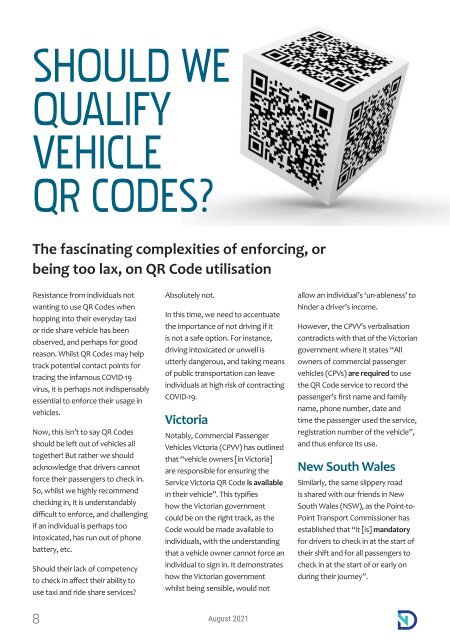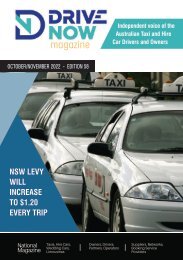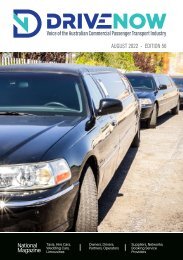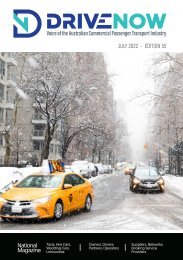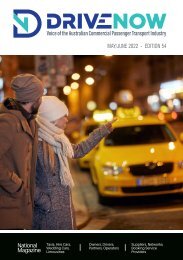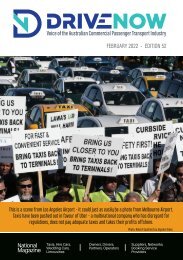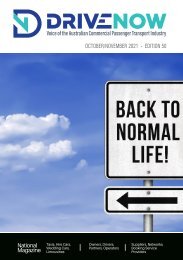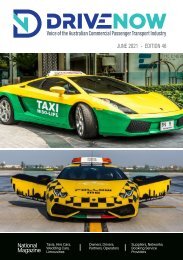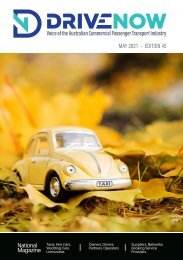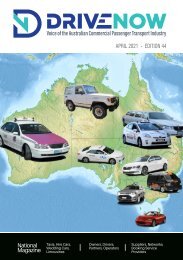DRIVE NOW August 2021
*** SCROLL DOWN TO SELECT ALTERNATIVE MAGAZINE EDITIONS *** Australia's only Magazine for the Commercial Passenger Transport Industry. News and views for Drivers, Owners and Operators of Taxi, Hire Car, Limousine, Ride Share, Booked Hire Vehicles, Rank and Hail Cars.
*** SCROLL DOWN TO SELECT ALTERNATIVE MAGAZINE EDITIONS ***
Australia's only Magazine for the Commercial Passenger Transport Industry. News and views for Drivers, Owners and Operators of Taxi, Hire Car, Limousine, Ride Share, Booked Hire Vehicles, Rank and Hail Cars.
Create successful ePaper yourself
Turn your PDF publications into a flip-book with our unique Google optimized e-Paper software.
SHOULD WE<br />
QUALIFY<br />
VEHICLE<br />
QR CODES?<br />
The fascinating complexities of enforcing, or<br />
being too lax, on QR Code utilisation<br />
Resistance from individuals not<br />
wanting to use QR Codes when<br />
hopping into their everyday taxi<br />
or ride share vehicle has been<br />
observed, and perhaps for good<br />
reason. Whilst QR Codes may help<br />
track potential contact points for<br />
tracing the infamous COVID-19<br />
virus, it is perhaps not indispensably<br />
essential to enforce their usage in<br />
vehicles.<br />
Now, this isn’t to say QR Codes<br />
should be left out of vehicles all<br />
together! But rather we should<br />
acknowledge that drivers cannot<br />
force their passengers to check in.<br />
So, whilst we highly recommend<br />
checking in, it is understandably<br />
difficult to enforce, and challenging<br />
if an individual is perhaps too<br />
intoxicated, has run out of phone<br />
battery, etc.<br />
Should their lack of competency<br />
to check in affect their ability to<br />
use taxi and ride share services?<br />
Absolutely not.<br />
In this time, we need to accentuate<br />
the importance of not driving if it<br />
is not a safe option. For instance,<br />
driving intoxicated or unwell is<br />
utterly dangerous, and taking means<br />
of public transportation can leave<br />
individuals at high risk of contracting<br />
COVID-19.<br />
Victoria<br />
Notably, Commercial Passenger<br />
Vehicles Victoria (CPVV) has outlined<br />
that “vehicle owners [in Victoria]<br />
are responsible for ensuring the<br />
Service Victoria QR Code is available<br />
in their vehicle”. This typifies<br />
how the Victorian government<br />
could be on the right track, as the<br />
Code would be made available to<br />
individuals, with the understanding<br />
that a vehicle owner cannot force an<br />
individual to sign in. It demonstrates<br />
how the Victorian government<br />
whilst being sensible, would not<br />
allow an individual’s ‘un-ableness’ to<br />
hinder a driver’s income.<br />
However, the CPVV’s verbalisation<br />
contradicts with that of the Victorian<br />
government where it states “All<br />
owners of commercial passenger<br />
vehicles (CPVs) are required to use<br />
the QR Code service to record the<br />
passenger’s first name and family<br />
name, phone number, date and<br />
time the passenger used the service,<br />
registration number of the vehicle”,<br />
and thus enforce its use.<br />
New South Wales<br />
Similarly, the same slippery road<br />
is shared with our friends in New<br />
South Wales (NSW), as the Point-to-<br />
Point Transport Commissioner has<br />
established that “it [is] mandatory<br />
for drivers to check in at the start of<br />
their shift and for all passengers to<br />
check in at the start of or early on<br />
during their journey”.<br />
8 <strong>August</strong> <strong>2021</strong>


